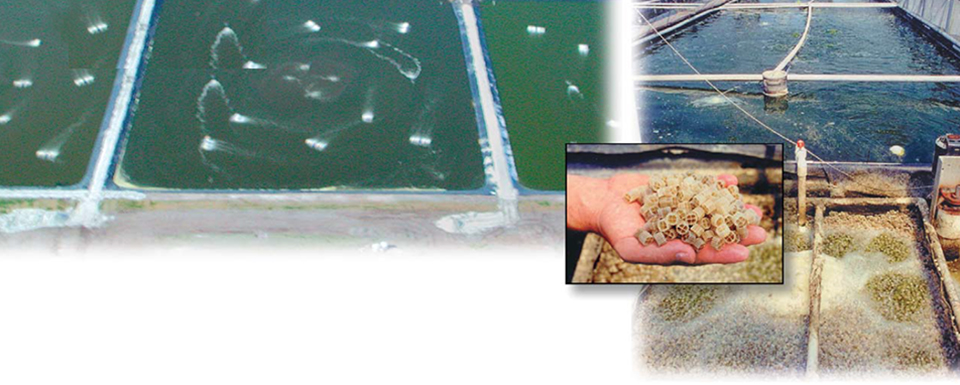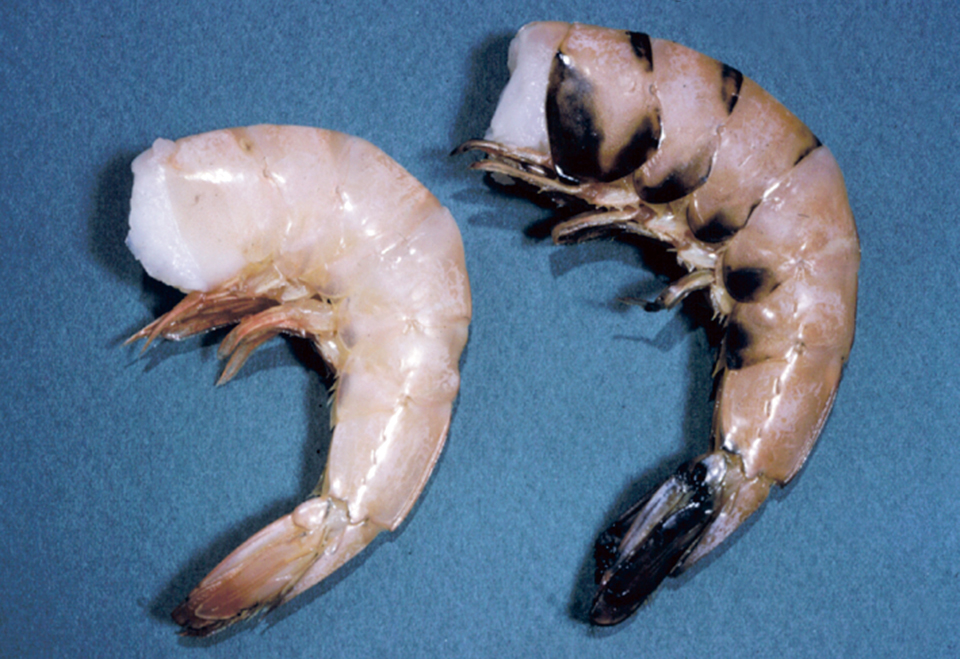Both are complementary in breaking down waste products into simpler, nontoxic compounds

Bacteria have critical roles in all aquaculture systems, and an adequate understanding of the differences between autotrophic and heterotrophic bacteria is important for the effective design and management of many aquaculture operations.
Varied traits, complementary roles
There are important differences between autotrophic and heterotrophic bacteria (Table 1). Heterotrophic bacteria obtain carbon and energy for growth from naturally occurring organic compounds, while autotrophs use carbon dioxide as their main source of carbon. Autotrophs obtain energy from light (photoautotrophs) or the oxidation of inorganic compounds such as ammonia (chemoautotrophs).
McGraw, Differences between autotrophic and heterotrophic bacteria, Table 1
| Characteristic | Autotrophs | Heterotrophs |
|---|---|---|
| Source of nutrition | Inorganic | Organic |
| Time to establish effective populations | Weeks | Hours |
| Survival of bacteria during stress | Inactive cells | Spore formation |
| Efficiency at nitrification | Excellent | Poor |
| Source of food for culture animals | Poor | Excellent |
Heterotrophs can survive a wider variety of environmental conditions than autotrophs, and have been prominent components of probiotic treatments in aquaculture. Autotrophs have been reported to survive weeks without an input of nutrients, while heterotrophs decrease in numbers very rapidly without food.
During periods of stress – such as limited food sources and low dissolved oxygen – autotrophs can survive through inactivity while heterotrophs form durable, long-lasting spores. Both spores and inactive autotrophic cells are activated when the right environmental conditions are encountered.
Autotrophic and heterotrophic bacteria exist in a complementary relationship. Heterotrophic bacteria produce carbon dioxide as an end product, which provides a carbon source for autotrophs, which in turn create biomass that will be eventually consumed by heterotrophs.
Heterotrophs as sources of nutrition
Nutrients from uneaten feed and excretion from culture animals in ponds can be efficiently recycled into valuable biomass by bacteria. Heterotrophic bacteria are important dietary components of detritivores such as shrimp, tilapia and carp.
Detritivores consume plant and animal remains or waste, sequentially reducing the particle sizes so that bacteria and fungi can break them down to their constituent chemical parts for recycling. About 10 percent of the available energy is passed on from one trophic level to the next, so organisms lower on the food chain, like detritivores, actually need less energy to grow.
Manure
Fish yields as high as 8,000 kilograms per hectare per year are achievable with manure fertilization alone. The manure itself is not nutritious, but rather a source of organic matter and substrate that allows the proliferation of heterotrophic bacteria and protozoa. Aggregates of organic matter and microorganisms are then ingested as food for fish such as tilapia and carp.
Rates of 2-4 kg of manure added to ponds can produce 1 kg of fish. As much as 10 percent of the biomass of shrimp in ponds can be provided through consumption of bacterial flocs. Manure added at 1,840 kilograms per hectare per week to small shrimp ponds stocked at 5 to 20 shrimp per square meter can produce a mean growth rate of 0.65 to 1.02 grams per week without the addition of supplemental feed.
Promoting heterotrophs
Encouraging the mass proliferation of heterotrophic bacteria as a food source in aerated, lined ponds is a viable option for intensive shrimp production. Production systems are currently using this new strategy by manipulating the carbon/nitrogen ratio of culture water through the addition of low-protein feeds or molasses. This promotes the formation of bacterial aggregates that are consumed by shrimp.
Heterotrophic systems tend to be more stable than typical phytoplankton-dominated pond systems, which rely on solar energy to grow. Sunlight can be limiting in ponds due to autoshading by dense plankton. This can lead to an eventual “crash,” which often results in the death of the target species unless intense aeration is provided.
Autotrophs in biofilters
Although both types of bacteria can nitrify inorganic ions (NH3, NO2, NO3), heterotrophic bacteria are far less likely to conduct nitrification in aquaculture systems due to their reliance on organic matter as a major source of energy. The addition of carbon to increase the carbon/nitrogen ratio in nitrogen-rich aquaculture water can reduce toxic ammonia levels in as little as a few hours through the exponential growth of heterotrophic bacteria. However, unless this excess bacterial biomass is consumed, it will decompose and release organic matter back into the culture environment.
Therefore, autotrophic nitrifiers are depended upon in recirculating systems to oxidize toxic ammonia to less-toxic nitrate. Unfortunately, autotrophs grow much more slowly than heterotrophs, and building up nitrifying bacteria in biofilters often takes weeks. However, compared to heterotrophs, much less autotrophic biomass is needed for the same rate of nitrification.
Heterotrophs in RAS
Heterotrophic bacteria are often considered a nuisance in biofilters used in recirculating aquaculture systems (RAS) because they outcompete autotrophic nitrifiers for oxygen when excessive organic matter is present. Separate components employed in closed systems remove organic matter to discourage the build-up of heterotrophic bacteria.
Filtration and waste
Mechanical filtration can be accomplished through sedimentation tanks and microscreens that remove particulate organic matter, while devices such as protein skimmers remove dissolved organic matter through foam fractionation. The major portion of nitrogen waste remaining is then in an inorganic form readily used by nitrifying bacteria.
Filter media
While nitrifiers can survive and grow without attachment to a solid surface, filter media with the maximum amount of surface area is known to promote the greatest density of nitrifiers. The bacteria can then thrive and proliferate through aggregations on solid surfaces and the formation of biofilm.
Inorganic ions are attracted to the surface of biofilm and solid-surface filter media, promoting greater nitrification and improved water quality. Nitrification rates are known to vary with environmental conditions. A usable surface area of bacteria of 0.2 square meters per grams of feed offered has been reported as a guideline.
Conclusion
Knowledge of the differences between autotrophic and heterotrophic bacteria is essential for the effective utilization of each type in aquaculture. One important use of autotrophic bacteria is nitrification in biofilters for recirculating systems. Heterotrophs break down organic matter and can be manipulated as a potential food source for detritivores, because of their fast growth and nutritional value.
Both bacteria types are complementary in breaking down waste products into simpler, nontoxic compounds. Heterotrophs are reliant on organic matter for nutrition, while autotrophs utilize inorganic ions.
(Editor’s Note: This article was originally published in the December 2002 print edition of the Global Aquaculture Advocate.)
Now that you've reached the end of the article ...
… please consider supporting GSA’s mission to advance responsible seafood practices through education, advocacy and third-party assurances. The Advocate aims to document the evolution of responsible seafood practices and share the expansive knowledge of our vast network of contributors.
By becoming a Global Seafood Alliance member, you’re ensuring that all of the pre-competitive work we do through member benefits, resources and events can continue. Individual membership costs just $50 a year.
Not a GSA member? Join us.
Author
-
William J. McGraw, Ph.D.
Taste of the Ocean Pty Ltd. ACN
P.O. Box 852
Sydney, NSW Australia 1230[109,111,99,46,100,110,111,112,103,105,98,64,109,98,95,111,116,111,116]
Related Posts

Intelligence
10 takeaways from GOAL 2019 in Chennai, India
The Global Aquaculture Alliance held its GOAL conference in Chennai, India, and recruited a host of experts in various fields to share their expertise.

Intelligence
4-hexylresorcinol: sulfite-free control for melanosis in crustaceans
4-hexylresorcinol in a nonsulfite processing treatment against melanosis in crustaceans inhibits natural enzymes for shell hardening.

Health & Welfare
A comprehensive look at the Proficiency Test for farmed shrimp
The University of Arizona Aquaculture Pathology Laboratory has carried out the Proficiency Test (PT) since 2005, with 300-plus diagnostic laboratories participating while improving their capabilities in the diagnosis of several shrimp pathogens.

Health & Welfare
A holistic management approach to EMS
Early Mortality Syndrome has devastated farmed shrimp in Asia and Latin America. With better understanding of the pathogen and the development and improvement of novel strategies, shrimp farmers are now able to better manage the disease.


